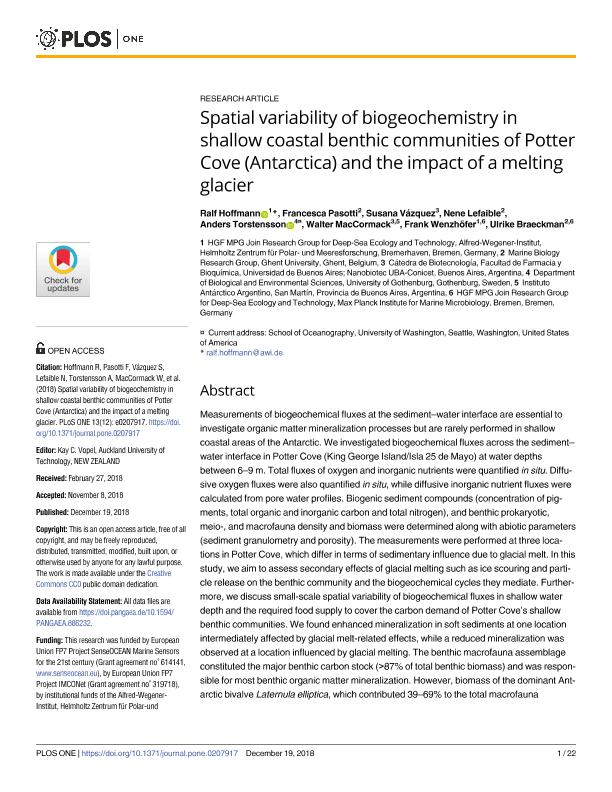Artículo
Spatial variability of biogeochemistry in shallow coastal benthic communities of Potter Cove (Antarctica) and the impact of a melting glacier
Hoffmann, Ralf; Passoti, Francesca; Vázquez, Susana Claudia ; Lefaible, Nene; Torstensson, Anders; Mac Cormack, Walter Patricio; Wenzhöfer, Frank; Braeckman, Ulrike
; Lefaible, Nene; Torstensson, Anders; Mac Cormack, Walter Patricio; Wenzhöfer, Frank; Braeckman, Ulrike
 ; Lefaible, Nene; Torstensson, Anders; Mac Cormack, Walter Patricio; Wenzhöfer, Frank; Braeckman, Ulrike
; Lefaible, Nene; Torstensson, Anders; Mac Cormack, Walter Patricio; Wenzhöfer, Frank; Braeckman, Ulrike
Fecha de publicación:
12/2018
Editorial:
Public Library of Science
Revista:
Plos One
ISSN:
1932-6203
Idioma:
Inglés
Tipo de recurso:
Artículo publicado
Clasificación temática:
Resumen
Measurements of biogeochemical fluxes at the sediment–water interface are essential to investigate organic matter mineralization processes but are rarely performed in shallow coastal areas of the Antarctic. We investigated biogeochemical fluxes across the sediment–water interface in Potter Cove (King George Island/Isla 25 de Mayo) at water depths between 6–9 m. Total fluxes of oxygen and inorganic nutrients were quantified in situ. Diffusive oxygen fluxes were also quantified in situ, while diffusive inorganic nutrient fluxes were calculated from pore water profiles. Biogenic sediment compounds (concentration of pigments, total organic and inorganic carbon and total nitrogen), and benthic prokaryotic, meio-, and macrofauna density and biomass were determined along with abiotic parameters (sediment granulometry and porosity). The measurements were performed at three locations in Potter Cove, which differ in terms of sedimentary influence due to glacial melt. In this study, we aim to assess secondary effects of glacial melting such as ice scouring and particle release on the benthic community and the biogeochemical cycles they mediate. Furthermore, we discuss small-scale spatial variability of biogeochemical fluxes in shallow water depth and the required food supply to cover the carbon demand of Potter Cove’s shallow benthic communities. We found enhanced mineralization in soft sediments at one location intermediately affected by glacial melt-related effects, while a reduced mineralization was observed at a location influenced by glacial melting. The benthic macrofauna assemblage constituted the major benthic carbon stock (>87% of total benthic biomass) and was responsible for most benthic organic matter mineralization. However, biomass of the dominant Antarctic bivalve Laternula elliptica, which contributed 39–69% to the total macrofauna.
Archivos asociados
Licencia
Identificadores
Colecciones
Articulos(NANOBIOTEC)
Articulos de INSTITUTO DE NANOBIOTECNOLOGIA
Articulos de INSTITUTO DE NANOBIOTECNOLOGIA
Citación
Hoffmann, Ralf; Passoti, Francesca; Vázquez, Susana Claudia; Lefaible, Nene; Torstensson, Anders; et al.; Spatial variability of biogeochemistry in shallow coastal benthic communities of Potter Cove (Antarctica) and the impact of a melting glacier; Public Library of Science; Plos One; 13; 12; 12-2018; 1-22
Compartir
Altmétricas



